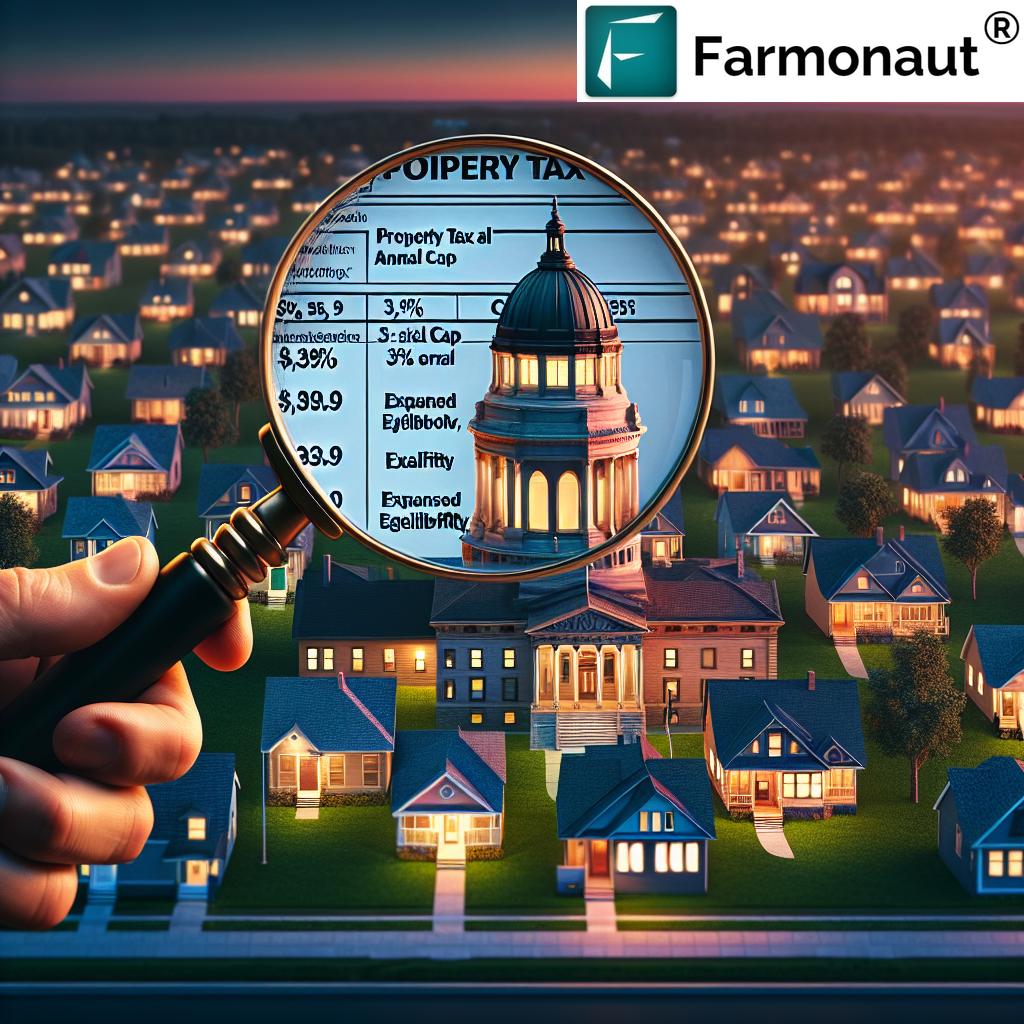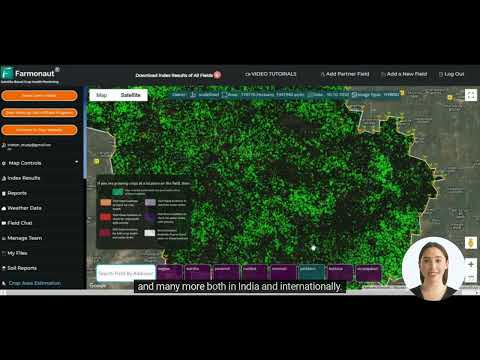South Dakota’s Property Tax Relief Plan: Proposed Caps and Expanded Programs for Homeowners
In the heart of America’s heartland, South Dakota is taking bold steps to address a pressing issue that has been weighing heavily on homeowners’ minds and wallets: rising property taxes. As we delve into the intricacies of the state’s comprehensive property tax relief plan, we’ll explore how this proposed legislation aims to reshape the landscape for homeowners and local governments alike.

“South Dakota’s proposed property tax plan caps county-wide residential property value growth at 3% annually for five years.”
As we navigate through the complexities of this groundbreaking proposal, it’s crucial to understand the context and potential impact on South Dakota’s communities. Let’s break down the key components of this property tax reform and analyze how it could affect homeowners, local governments, and the state’s fiscal landscape.
The Catalyst for Change: Rising Home Values and Tax Burdens
In recent years, South Dakota has experienced a significant surge in home values, particularly in certain areas of the state. This rapid appreciation has led to a corresponding increase in property tax assessments, creating a substantial financial burden for many homeowners. The public outcry over these rising taxes has not fallen on deaf ears, prompting lawmakers to take action and address this pressing issue head-on.
Governor Larry Rhoden, recognizing the urgency of the situation, has spearheaded a legislative effort to provide relief to homeowners while balancing the needs of local governments. The result is a comprehensive property tax relief plan that aims to cap growth in owner-occupied home valuations and impose stricter limits on local government tax collections.
Key Provisions of the Proposed Property Tax Relief Plan
Let’s examine the core elements of South Dakota’s proposed property tax relief plan:
- Five-Year Cap on Home Valuations: The plan introduces a 3% annual cap on the growth of county-wide residential property values for a period of five years. This measure aims to slow the rapid increase in assessed home values that has been driving up tax bills.
- Protection for Home Improvements: Improvements valued at less than 40% of a home’s total worth would be shielded from factoring into a county’s total property value. This provision encourages homeowners to invest in their properties without fear of immediate tax repercussions.
- Stricter Limits on Local Government Tax Collections: The proposal would cap the annual growth in local government property tax collections based on new construction and home improvements at 2%, down from the current 3% or rate of inflation.
- Expanded Eligibility for Relief Programs: Income limits for the state’s property tax freeze relief program for elderly and disabled residents would be increased, making more homeowners eligible for assistance.
- Adjustments to School Funding: The plan would apply the 2% growth limit to school capital outlay funds, potentially impacting how schools finance land, buildings, and equipment purchases.
These provisions represent a multi-faceted approach to addressing the property tax issue in South Dakota, targeting both the assessment of property values and the collection of taxes by local governments.
The Impact on Homeowners and Local Governments
The proposed property tax cap and related measures are designed to provide significant relief to homeowners across South Dakota. By limiting the growth in assessed property values and imposing stricter caps on tax collections, the plan aims to slow the rate of increase in property tax bills that many residents have experienced in recent years.
For homeowners, this could mean more predictable and manageable property tax obligations, potentially saving hundreds or even thousands of dollars annually. The expanded eligibility for relief programs would also provide additional support to vulnerable populations, such as the elderly and disabled, who may be struggling with rising housing costs.
However, the impact on local governments and school districts cannot be overlooked. These entities rely heavily on property tax revenue to fund essential services and educational programs. The proposed caps on tax collections and school capital outlay funds may require local governments and school districts to reassess their budgets and potentially find alternative funding sources or ways to increase efficiency.
“The plan expands eligibility for elderly and disabled tax relief programs by increasing income limits for qualification.”
A Closer Look at the Proposed Changes
To better understand the potential impact of South Dakota’s property tax relief plan, let’s examine a comparative analysis of current policies and proposed changes:
| Policy Area | Current Policy | Proposed Changes | Potential Impact on Homeowners |
|---|---|---|---|
| Valuation Cap | No statewide cap on residential property value growth | 3% annual cap on county-wide residential property value growth for 5 years | Slower increase in assessed home values, potentially lower tax bills |
| Home Improvements | All improvements factor into property value assessments | Improvements valued at less than 40% of home’s worth shielded from assessments | Encourages home improvements without immediate tax increases |
| Tax Collection Limits | 3% or inflation rate (whichever is lower) plus growth from new construction | 2% cap on growth from new construction and home improvements | Slower growth in overall property tax burden |
| Relief Programs | Income limit of $45,000 for multi-person households | Income limit increased to $65,000 for multi-person households | More homeowners eligible for tax relief, particularly elderly and disabled |
| School Funding | No specific cap on capital outlay fund growth | 2% cap on annual growth in school capital outlay funds | Potential for slower growth in school-related property taxes |
This comparative analysis highlights the significant changes proposed in South Dakota’s property tax relief plan. By implementing these measures, the state aims to create a more stable and predictable property tax environment for homeowners while also addressing the fiscal needs of local governments and school districts.
The Legislative Journey and Public Response
The path to property tax reform in South Dakota has been marked by intense debate and competing proposals. Governor Rhoden’s plan, introduced as Senate Bill 216, represents a compromise reached by a property tax working group consisting of 10 state lawmakers and representatives from the governor’s office.
At a press conference in Pierre, Governor Rhoden emphasized the collaborative nature of the proposal, stating, “This is an agreement reached by our property tax working group, and I want to thank them for their passion to relieve the tax burden on South Dakota homeowners.”
The public response to the proposed plan has been mixed, with many homeowners expressing relief at the prospect of slower-growing tax bills. However, some local government officials and school administrators have voiced concerns about the potential impact on their budgets and ability to provide essential services.
Challenges and Considerations
While the proposed property tax relief plan offers significant benefits to homeowners, it also presents several challenges and considerations that lawmakers and stakeholders must address:
- Long-term Fiscal Sustainability: The 3% cap on property value growth and 2% limit on tax collection increases may impact the long-term fiscal health of local governments and school districts. It’s crucial to consider how these entities will adapt to potentially slower revenue growth.
- Economic Fluctuations: The five-year cap on home valuations may not account for significant economic changes or shifts in the housing market. Mechanisms for adjusting the plan in response to unforeseen circumstances may be necessary.
- Equity Concerns: While the plan aims to provide broad relief, there may be disparities in its impact across different regions of South Dakota or among various income levels. Ensuring equitable relief for all homeowners will be a key consideration.
- Implementation and Administration: The proposed changes will require significant adjustments to current assessment and tax collection processes. County assessors and local government officials will need support and resources to implement these changes effectively.
The Broader Context: Property Tax Reform Across the Nation
South Dakota’s efforts to address property tax burdens are part of a larger national trend. Many states across the U.S. are grappling with similar challenges as rising home values and increased demand for local services put pressure on property tax systems. Some approaches being explored in other states include:
- Circuit breaker programs that provide tax credits when property taxes exceed a certain percentage of household income
- Assessment freezes for specific groups, such as seniors or veterans
- Split-rate taxation systems that tax land and improvements at different rates
- Increased state funding for local services to reduce reliance on property taxes
As we analyze South Dakota’s proposed plan, it’s valuable to consider how it compares to and potentially improves upon reform efforts in other states.
The Role of Technology in Property Tax Administration
As South Dakota contemplates significant changes to its property tax system, it’s worth noting the increasing role of technology in property assessment and tax administration. Advanced mapping and data analysis tools can help ensure more accurate and fair property valuations, while digital platforms can streamline the tax payment process for homeowners.
Companies like Farmonaut, while primarily focused on agricultural technology, demonstrate the potential for satellite-based and AI-driven solutions in land management and valuation. While not directly applicable to residential property taxes, such technologies highlight the broader trend towards data-driven decision-making in land-related policies.
As South Dakota implements its property tax relief plan, leveraging cutting-edge technology could help in accurately assessing property values, monitoring growth rates, and ensuring compliance with the new caps and limits.
Looking Ahead: The Future of Property Taxes in South Dakota
As South Dakota moves forward with its property tax relief plan, several key questions and considerations will shape the future of property taxation in the state:
- Adaptability: How will the plan adapt to changing economic conditions and housing market fluctuations over the five-year implementation period?
- Local Government Funding: What alternative revenue sources or efficiency measures will local governments and school districts explore to maintain service levels under the new tax collection limits?
- Long-term Sustainability: How will the state balance homeowner relief with the long-term fiscal health of local entities and the need for infrastructure investment?
- Equitable Relief: Will additional measures be needed to ensure that property tax relief is distributed equitably across different income levels and geographic areas of the state?
- Technology Integration: How can South Dakota leverage advanced technologies to improve property assessment accuracy and tax administration efficiency?
These questions will likely drive ongoing discussions and potential adjustments to the property tax relief plan in the coming years.
Conclusion: A Bold Step Towards Property Tax Reform
South Dakota’s proposed property tax relief plan represents a significant and multifaceted approach to addressing the challenges of rising property taxes. By implementing caps on property value growth, limiting tax collection increases, and expanding relief programs, the state aims to provide much-needed relief to homeowners while maintaining essential local government functions.
As the plan moves through the legislative process and potentially into implementation, it will be crucial for all stakeholders – homeowners, local government officials, school administrators, and state lawmakers – to remain engaged in the dialogue. The success of this reform effort will depend on ongoing assessment, potential adjustments, and a commitment to balancing homeowner relief with the fiscal needs of local communities.
South Dakota’s bold step towards comprehensive property tax reform could serve as a model for other states grappling with similar challenges. As we move forward, the lessons learned from this initiative will undoubtedly contribute to the broader national conversation on property tax policy and local government funding in the 21st century.

FAQ: South Dakota’s Property Tax Relief Plan
- Q: When will the proposed property tax relief plan take effect?
A: If passed, the plan is set to be implemented over a five-year period, with specific start dates to be determined by the legislature. - Q: How will the 3% cap on property value growth be calculated?
A: The cap will apply to the total assessed value of all owner-occupied homes in a county, not individual properties. County assessors will need to adjust their methodologies to ensure the overall growth stays within this limit. - Q: Will commercial and agricultural properties be affected by this plan?
A: The current proposal focuses primarily on owner-occupied residential properties. Commercial and agricultural lands are not subject to the same caps under this plan. - Q: How will the expanded relief programs for elderly and disabled homeowners work?
A: The plan increases income limits for eligibility and raises the maximum home value that qualifies for the program. Specific details and application processes will be provided by the state tax office. - Q: What happens if a local government needs to exceed the new tax collection limits?
A: The proposal maintains the current “opt-out” provision, allowing local governments to exceed limits with a two-thirds voter approval.
As we conclude our exploration of South Dakota’s comprehensive property tax relief plan, it’s clear that this initiative represents a significant step towards addressing the pressing issue of rising property taxes in the state. The proposed measures aim to provide substantial relief to homeowners while balancing the needs of local governments and school districts.
While the plan offers promising solutions, its success will ultimately depend on careful implementation, ongoing monitoring, and the ability to adapt to changing economic conditions. As South Dakota moves forward with this bold reform, it will be essential for all stakeholders to remain engaged in the process, ensuring that the benefits of property tax relief are realized equitably across the state.
For those interested in staying informed about the latest developments in property tax policy and other land-related issues, resources like Farmonaut offer valuable insights into land management and valuation technologies. While primarily focused on agricultural applications, such platforms demonstrate the potential for data-driven approaches in policy implementation and land assessment.
As South Dakota embarks on this journey of property tax reform, it sets an example for other states facing similar challenges. The lessons learned from this initiative will undoubtedly contribute to the ongoing national dialogue on property taxation, local government funding, and the balance between homeowner relief and community needs.
Earn With Farmonaut: Join Farmonaut’s affiliate program and earn a 20% recurring commission by helping farmers save 10% with your promo code. Onboard 10 Elite farmers monthly to potentially earn $148,000+ annually. Start growing your income today!






